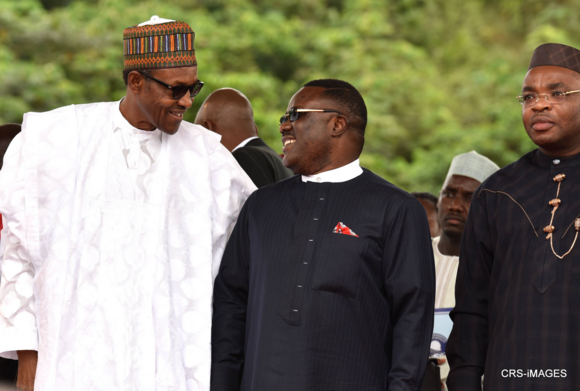Recently, the Cross River State Governor, Senator Ben Ayade returned to the State after a week-long visit to Abuja. While being received at the Margret Ekpo International Airport, Calabar by his Deputy, Prof Ivara Esu and some of his appointees, the Governor announced that he “had a fruitful session with the Presidency and I want to announce with joy that the Presidency has shown a very strong commitment to the Bakassi Deep Seaport and Superhighway which is basically the core reason for my being in Abuja for this long”. The State government later announced that the “signature projects” will be provided for by the Federal Government in its budget for the year 2022.
Naturally, these words should be pleasing to the people of Cross River State but considering that the Governor has previously made many announcements with a sense of finality of deals sealed with investors ready to finance the projects without any actually becoming a reality, and for some other reasons which I will explain here, this announcement appears to be the latest in a long line of subterfuges that have become associable with the projects.
It is unclear what would be the actual cost of the “signature projects” but for this article, I will work within the estimates given by the Cross River State Government. In October 2019, the Chairman of Cross River State’s Debt Review and Project Development Commission, Barr Chris Agara, gave total estimated for completion of the Deep Seaport at between 1.7 billion dollars and 2 billion dollars while the cost was put at N64Billion for the proposed super highway when Governor Ben Ayade wrote to the State House of Assembly in February 2019 seeking approval to borrow to fund the project. Ergo, about 3 billion Dollars is needed to complete both signature projects.
The 2021 budget of the Federal Republic of Nigeria as approved by the National Assembly was N13.588 trillion or $32.8Billion. And if global oil prices do not increase drastically leading to more revenue for the Federal Government, it is safe to assume that the total budget sum for 2022 will not be much higher. Therefore expecting that the Federal Government will allocate over $3 Billion or about 10% of it’s national budget to the construction of the proposed Bakassi deep seaport and the super highway is at the very least, farfetched.
It is an incontrovertible fact that the presence of a fully functional port in Calabar will unlock the economic potential of the agricultural, commercial and tourism sector in not just Cross River State but also the entire Eastern and North-Eastern flank of Nigeria. So Governor Ben Ayade’s idea of having a functional port and an “evacuation corridor” is in its core essence, a visionary template. But his plan to build a brand new deep seaport and a superhighway from scratch to achieve that goal is unrealistic and not well thought out, considering the low monthly federal allocation and internally generated revenue of the State, coupled with a huge debt burden.
My position is not driven by some short-term considerations or prompted by the current political context. It is what I have said on numerous occasions and what I firmly believe. I will therefore attempt to explain my position in detail and share my assessments of today’s situation.
It is important to remember that the Calabar port which already exists, historically served as an important point of trade with the outside world for the Eastern States and the Northern States of Nigeria right from the pre-colonial and colonial times. Unfortunately, operations at the port have for decades been severely hampered by the naturally shallow depth of around 7m along the 84km Calabar channel. The problem has lingered for this long because a combination of graft, corruption and a seeming lack of political will have hampered successive efforts to dredge the port channel to the required depth.
The contract for the dredging of the Calabar Port channel was first awarded during the administration of the late General Sani Abacha in 1996 to a little known Chinese company. The company was fully paid the contract sum but didn’t even bother to mobilize to the site. The contract was re-awarded to Van Oord and Jan de Nul at the cost of N3bllion. That contract was mired in controversy leading to two Dutch firms doing barely half of the job before leaving the site.
In 2006, the administration of former President Olusegun Obasanjo re-awarded the contract to the same firms for $56m (N20.44billion). This time, the firms stopped work after scooping out 25 million cubic metres of sand to achieve an overall draft of eight metres. It was suspected that this was done with the knowledge and connivance of some people in government at that time.
Later, former Minister of Transport, Dr Abiye Sekibo awarded another $14 million contract to the two firms to complete the job, but the money still went down the drain.
President Goodluck Jonathan in 2014 awarded the dredging contract to Niger Global Engineering and Technical Company Limited (NGETCL), a company owned by the current Governor of Imo State at the cost of $12.5 million (N20 billion). The contract was terminated three years later over alleged fraud in the award process and shoddy execution.
Besides all the graft and corruption that plagued the series of contracts for the dredging of the Calabar port, utterances by some former Managing Directors of the Nigerian Ports Authority suggests there was a kind of ambivalence or reluctance towards actually dredging the port.
Engineer Omar Suleiman who was the Managing Director of the Nigerian Ports Authority (NPA) from December 2010 to July 2012 tried to justify the failure to dredge the port in an interview with the press sometime in 2016 by saying “If you dredge it this month with $100 million, in six months you will need to dredge it again”.
Also, in an interview with the press in July 2019, Hadiza Bala-Usman, the then Managing Director of the NPA said: “So we have started another process. But it translated into huge volumes to the extent that we are looking at spending about N45-50billion on dredging of Calabar Port.
“When you look at the volumes of cargo that can come to that region, it’s not very high so there is no justification in terms of revenues coming into the port to justify that volume of investment”.
The truth is that the Calabar port channel can be deepened by dredging it to depths of 13 meters or more for a fraction of what it would cost to build a new deep seaport. The channel depth would thereafter be periodically maintained. A depth of 13 metres should allow a Panamax vessel with 5,000 TEU capacity to visit the port with ease. Thus making the port viable. Let’s not forget that the Apapa and Tin-can Island ports in Lagos both have average terminal depths of 13m.
It is instructive to note that Van Ord and Jan De Nul (two companies previously mentioned in this article among the many companies that had failed to execute their contracts to dredge the Calabar channel), participated in the deepening and widening of the original Suez Canal in Egypt which connects the Mediterranean Sea with the Red Sea and is the fastest shipping route between Europe and Asia, from depths of 8 metres to the current depths of 24 metres. An indication that a lack of technical capacity wasn’t the cause of their failure to dredge the Calabar port.
When working on this article, I relied on open-source documents that contain well-known facts rather than on some secret records. Governor Ben Ayade sadly preferred to overlook these facts, else he would have sought an easier and more achievable arrangement whereby the State Government could undertake the deepening of the Calabar Port channel by dredging it to a depth of 13 metres or more and even carrying out the periodic maintenance pending when the Federal Government can make refunds to it. Governor Ayade rather chose to go on a wild goose chase in search of $3 Billion to build a brand new deep seaport and superhighway.
Interestingly, some media reports have indicated that some experts believe that Esuk Usung Iwang Beach in Esighi which is the site for the proposed seaport project has a depth of 7 metres (falling to as low as 1 metre during low tide), which is not suitable for a port.
Efiom Attoe writes from Calabare And can be reached via efiomattoe@gmail.com










